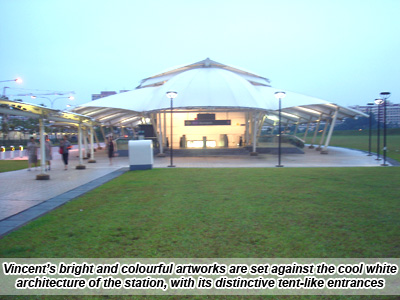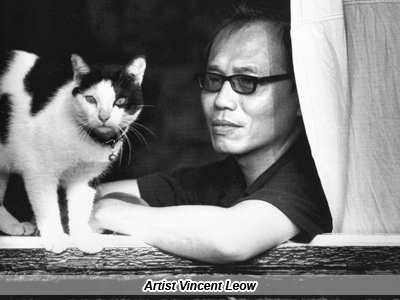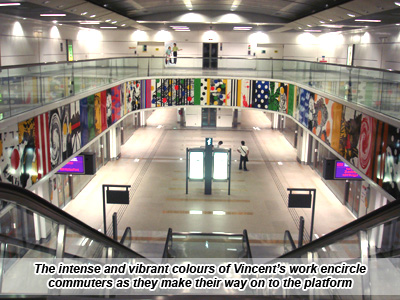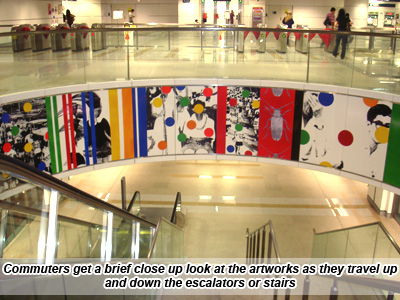|

Buangkok station
Buangkok station often
draws stares from passer-bys intrigued by its distinctive,
abstract look. Resembling a circus tent, the
station's unique Teflon roof covers the
station entrances, linkways and bus-stops. While fulfilling
its function, the roof's unconventional design is a visual
treat that draws passengers into the
station.

A tunnel from Buangkok
station links it to the North East Line depot, and trains
from the city can be re-routed off the main line to
return to the depot. This two-level
station built under Sengkang Central Road has also been
designed as a civil defence shelter.
The formerly undeveloped
area has welcomed increased accessibility with the new MRT
station. A network of new roads, such as
Buangkok Green and Sengkang
Central Road were constructed to complement the new station.
Future developments around the station, which sits between
Sengkang and Hougang Towns, will
certainly embrace the new transport links.
Back To Top
Vincent Leow's works at
Buangkok station capture the energy and open-mindedness of
Singapore's contemporary arts scene.

For his commission at
Buangkok station, Vincent Leow decided against creating the
paintings and sculptures for which he is best
known. Instead he seized the
opportunity to push his own artistic boundaries by exploring
the fusion of art and photography.
The artist's concept
cleverly uses the station's spaces to create a bold
contemporary work that embodies the essence of transit
art and the fleeting approach
commuters have to it.
Back To Top
Vincent Leow's work is
made up of two colourful bands of images framing the
station's two open stair voids that link the concourse
level to the platform. Commuters
riding the escalators from the concourse down to the
trains
and from the train platform up towards ground level will
find themselves on eye level with Vincent's
unique collection of black and white photos, artfully
enlivened with colours, dots and graphic motifs.
Comprising 80 vitreous
enamel panels silk-screened with different images, Vincent
Leow's work resembles movie stills or film
strips featuring photos of people,
activities and nature.

Conscious of how commuters
rush through a station, he designed his work to be
appreciated as a whole or in easily digestible bite
sizes if commuters so
wished.
There isn't any focal
point for his works. Each image is meant to express his
thoughts. The artist expects commuters to be on eye
level with the works for no more
than 10 to 15 seconds each time they pass through the
station. People are in a rush so they will probably pick up
different things from the work each time.
Back To Top
There is an element of
intrigue in Vincent Leow's work; a subtle sense of
"now-you-see-it, now-you-don't". In fact, the blown-up
photo images look abstract, almost
like a collection of dots, when viewed in close-up. It is
only when viewed from afar that the whole image comes into
focus.
The black and white
photos, which the artist obtained from the National
Archives, were chosen to give a flavour of what life used
to be like in Buangkok and other
rural areas similar to it. The artist's idea was to connect
with commuters; those from Buangkok as well as those from
all over Singapore who travel through
Buangkok station.
Elements of everyday
Singapore life are woven into his works, from the traffic
police to a soldier on parade to the vitamin pills
that working people take every
morning before heading to the station and to work.
The images also double up
as a commentary on life in Singapore. The photo of the
soldier on parade might remind us about
national service; a rite of passage into
adulthood for most Singapore men. Similarly, people could
interpret the police presence as being a case of "Big
Brother's watching". That's one way of looking at it.
You can also think of it as the police being there to
protect us.
Vincent Leow's works don't
just take commuters on a walk back in time. It is the loud,
even audacious embellishments on the
black and white photos, expressed as
coloured dots, bands of colours or graphic motifs that will
make commuters stop in mid-stride to take a second look at
the work. And this too, is part of the artist's
intention.

Back To Top
Reaching beyond
aesthetics, Vincent employs different devices to create
layers of meaning in his works, his use of colour being
one such method. He wanted an
explosion of colours in the station - to create a bright,
happy ambience. Primary colours were the obvious choice
because they literally scream "Look at me! Look at
me!" Hopefully, it will reflect the energy of the people who
live in Buangkok now.
There is a reason behind
the dots that pepper just about every single one of the
photos, adding a gentle hint of irreverence to
what might have been a documentary-
style treatment. Vincent very much a child of his time
relates to dots as they blur out certain images while
creating a new image. They allow you to play with layers
of images. You can choose to look at the dots or the
pictures behind them.
In the same way, the
graphic symbols and illustrations in his work help him make
an emotional connection with his audience.
Examples of such symbols include
computer-manipulated images of fishes which were chosen due
to its auspiciousness.
Some of the images may
have red or tangerine clouds floating through them. The
cloud patterns are based on the cloud drawings
used in Chinese folk art.
The artist's original
works, which were on paper, and in electronic files, were
converted into silkscreen images on vitreous enamel
panels.
The artist's distinctive
artwork certainly shows that he made the most of his
opportunities. Indeed, the vibrant colours and bold
images of Vincent Leow's work at
Buangkok station seem to invite commuters to exult in the
many possibilities of our times, and to share in the
artist's zest for life.
Artist:
Vincent Leow
Born: Singapore, 1961
Education:
- Diploma in Fine Art & Design, 1987
LASALLE-SIA College of the Arts, Singapore
- Masters in Fine Art, 1991
Maryland Institute, Mount Royal Graduate School of
Art, Baltimore, USA
next: Sengkang station
Back To Top
|